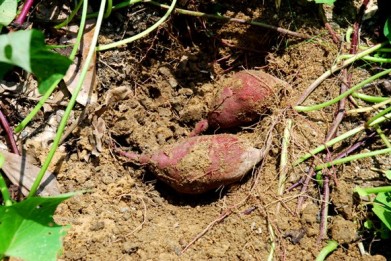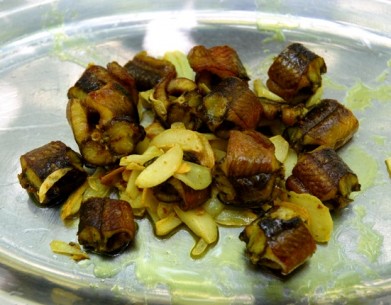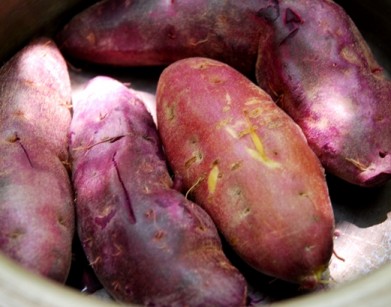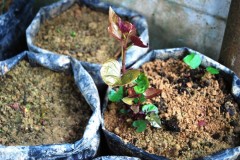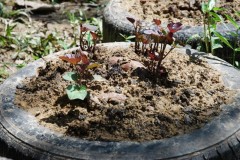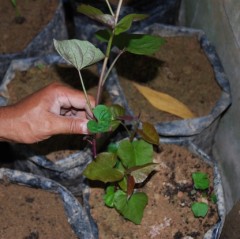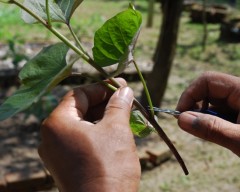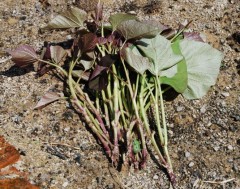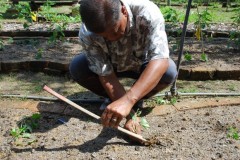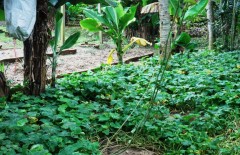Apr 25, 2011
Lunch At the Farm
The sweet potatoes are ready for harvest just 70 days after planting. That's fast, and they achieved a good size too.
We decided to have a quick lunch - plain steamed sweet potatoes, and a wild eel that was wriggling across our path as we were inspecting the sweet potatoes.
Wild eel rubbed in some kunyit (turmeric), stir-fried in grassfed chicken fat with garlic. Those of you who know good food can imagine just how delicious this dish is!
Purple and yellow sweet potatoes for their antioxidant (anthocyanin), their high fibre, and their ability to keep blood sugar levels stable ( they are a source of natural 'caiapo', a supplement for the diabetic to control blood sugar ).
To add an exotic gourmet touch to the plain steamed potato, make a dry topping of grated coconut, sugar and salt to taste. Sprinkle over bite-size sweet potato, or spoon on top of each chunky slice.
Postscript: This huge guy crossed our path a few days later. Our experiment to create a sustainable mini-scale natural fishery by slowing down sections of the stream, feeding, etc seems to be producing result.
Click on pic for close - up
12:13 Posted in Blog | Permalink | Comments (8) | Tags: eel, wild eel, sweet potato, purple sweet potato, anthocyanin, caiapo, diabetic food, diabetic superfood, slow food
Jan 17, 2011
Sweet Potatoes for the beginner organic farmer
Sweet potatoes are ideal for the beginning organic farmer and the beginning permaculturist. It is an undemanding crop and do not require high nitrogen inputs ( which equal to less costs and less disease problems).
If you are trying to earn some extra cash, then grow the purple colored varieties as they fetch a higher price and is always in demand (because of its higher antioxidant content). Organic shops will buy them off you anytime.
To grow them, start a nursery with tubers ( of the quality and variety you want ) as follows:
This one uses a conventional black nursery poly bag.
Here we use discarded tyres from tyre shops at no costs.
Instead of a nursery, you can also use cuttings from fully grown vines from existing sweet potatoe patches (so long as you know the quality).
When the shoots or slips, as they are called, are about 8 inches long, snip them off and plant to soil.
The slip is snip off to plant. The tuber will continue to provide slips for months.
Snip off the lower leaves before planting.
Bunch of slips
Insert the slip into the soil at an angle using a bamboo or a piece of wood.
A planted bed.
Raised beds are preferred. Use sandy soil. Do not fertilise with high nitrogen fertilisers such as chicken dung. Use vermicast, compost or humus. Sweet potato is ready for harvest in 4 months (depending on variety).
The home gardener or small-scale farmer can start a nursery in one tyre and then plant individual slips in seperate tyres as follows:
Planting in tyres as raised beds to make use of land with bad clayey soil at the farm (click on pic for close up)
Each tyre will then produce one crop of sweet potatoes and you harvest as and when you need them.
At our farm, we also plant sweet potatoe as a living mulch:
10:38 Posted in Permaculture | Permalink | Comments (0) | Tags: sweet potato, ipomoea batatas, purple sweet potato, slips









